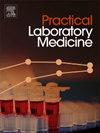Liquid chromatography-tandem mass spectrometry assay for simultaneous quantification of catecholamines and metabolites in human plasma and cerebrospinal fluid
IF 1.7
Q3 MEDICAL LABORATORY TECHNOLOGY
引用次数: 0
Abstract
Catecholamines (CAs) and their metabolites in human cerebrospinal fluid (CSF) and plasma are potential biomarkers of Alzheimer's disease (AD) and facilitate early diagnosis. Liquid chromatography-tandem mass spectrometry is the gold standard method for analyzing CAs. The objective of this study was to develop and validate a liquid chromatography-tandem mass spectrometry assay capable of simultaneously quantifying dopamine (DA), epinephrine (E), norepinephrine (NE), metanephrine (MN), normetanephrine (NMN), and 3-methoxytyramine (3-MT) in both human CSF and plasma. Samples were processed by solid-phase extraction with a weak cation exchange adsorbent and then separated using an ultra-performance reversed-phase chromatography column. Analyte detection was performed using a triple quadrupole mass spectrometer operated in positive-ion multiple reaction monitoring mode. The developed assay was validated according to standard guidelines. The linearity, specificity, precision, accuracy, carryover and stability were assessed to ensure compliance with specified criteria. The lower limits of quantification for DA, E, NE, MN, NMN, and 3-MT were 4.5, 2.5, 4.5, 2.5, 2, and 0.3 pg mL−1, respectively. The total runtime for a single sample was 6.5 min. These results demonstrated that the method was sensitive, rapid, and reliable for the simultaneous quantification of DA, E, NE, MN, NMN, and 3-MT in clinical practice. We successfully detected CAs and their metabolites in plasma and CSF samples from patients with normal cognition and AD. This study demonstrates an efficient laboratory workflow for high-throughput analysis of CAs and their metabolites and lays a foundation for further studies on AD biomarkers.
同时定量测定人血浆和脑脊液中儿茶酚胺及其代谢物的液相色谱-串联质谱法
人脑脊液(CSF)和血浆中的儿茶酚胺(CAs)及其代谢物是阿尔茨海默病(AD)的潜在生物标志物,有助于早期诊断。液相色谱-串联质谱法是分析CAs的金标准方法。本研究的目的是建立并验证一种液相色谱-串联质谱分析方法,该方法能够同时定量人脑脊液和血浆中的多巴胺(DA)、肾上腺素(E)、去甲肾上腺素(NE)、肾上腺素(MN)、去甲肾上腺素(NMN)和3-甲氧基酪胺(3-MT)。样品经弱阳离子交换吸附剂固相萃取处理后,采用高性能反相色谱柱分离。分析物检测使用三联四极质谱计进行,以正离子多重反应监测模式操作。根据标准指南对所建立的测定方法进行了验证。对其进行线性、特异性、精密度、准确度、结转性和稳定性评估,确保符合规定标准。DA、E、NE、MN、NMN和3-MT的定量下限分别为4.5、2.5、4.5、2.5、2和0.3 pg mL−1。结果表明,该方法对DA、E、NE、MN、NMN和3-MT的同时定量检测灵敏、快速、可靠。我们成功地在正常认知和AD患者的血浆和脑脊液样本中检测到CAs及其代谢物。本研究为CAs及其代谢物的高通量分析提供了高效的实验室工作流程,为进一步研究AD生物标志物奠定了基础。
本文章由计算机程序翻译,如有差异,请以英文原文为准。
求助全文
约1分钟内获得全文
求助全文
来源期刊

Practical Laboratory Medicine
Health Professions-Radiological and Ultrasound Technology
CiteScore
3.50
自引率
0.00%
发文量
40
审稿时长
7 weeks
期刊介绍:
Practical Laboratory Medicine is a high-quality, peer-reviewed, international open-access journal publishing original research, new methods and critical evaluations, case reports and short papers in the fields of clinical chemistry and laboratory medicine. The objective of the journal is to provide practical information of immediate relevance to workers in clinical laboratories. The primary scope of the journal covers clinical chemistry, hematology, molecular biology and genetics relevant to laboratory medicine, microbiology, immunology, therapeutic drug monitoring and toxicology, laboratory management and informatics. We welcome papers which describe critical evaluations of biomarkers and their role in the diagnosis and treatment of clinically significant disease, validation of commercial and in-house IVD methods, method comparisons, interference reports, the development of new reagents and reference materials, reference range studies and regulatory compliance reports. Manuscripts describing the development of new methods applicable to laboratory medicine (including point-of-care testing) are particularly encouraged, even if preliminary or small scale.
 求助内容:
求助内容: 应助结果提醒方式:
应助结果提醒方式:


